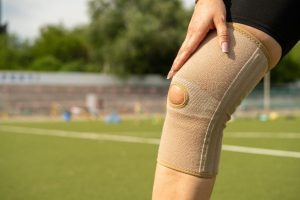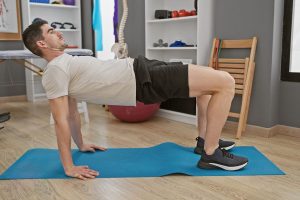Do you ever have painful clicking in your jaw? It’s possible that you’re suffering from TMD, a disorder of the temporomandibular joint (TMJ). This can even lead to neck pain and headaches. Of course, it’s always best to be checked out by a professional for an official diagnosis, but TMJ home treatment can help!
We hope that this post can provide an effective avenue for self care of TMJ at home with this DIY physical therapy plan. In this post, we will provide a 2-minute solution to TMJ pain.
Pain from the temporomandibular joint (TMJ) affects 10 million people or possibly more in this country. Pain from this area will impact women twice as often as men. This is likely related to the frequency of joint hypermobility being more prevalent in women compared to men.
The TMJ is a synovial hinge joint. This means that it’s a joint between two bones that move against each other, like the knee. The TMJ serves as the connection between the skull (temporal bone) and the jaw, (mandible bone). It contains a meniscus-like disc that serves to cushion the joint.
The TMJ may be the primary cause of pain and dysfunction, or it may be a secondary response to other issues, just like individuals who are experiencing “sciatica” pain in the leg caused by issues in the back. In any case there are some simple things to do to decrease pain in this area.
TMJ Symptoms
Temporomandibular joint disorders, known as TMD’s, have many symptoms. Some affect the jaw joints directly, and some don’t.
- Biting or chewing difficulty
- Jaw pain or discomfort
- Clicking, popping, or grating sound when opening or closing the mouth.
- Dull, aching pain in the face.
- Earache
- Headache
- Vertigo (dizziness)
- Tinnitus (ringing in the ears)
- Malocclusion (cross bite)
- Inability to fully open
Causes of TMJ Disorders
There are several causes of TMJ dysfunction (TMD). These may include:
Direct trauma
If you take a blow to your jaw, head and neck from a punch, a fall or car accident this may strain the joint.
Takeru Kobayashi, the world champion hotdog eater, suffered an injury to his TMJ, so on occasion “sports injuries” may impact the TMJ.
Poor posture
The TMJ hangs on your skull. The skull rests on your spine. The position of your head on your neck is a primary cause as well as contributing factor influencing pain and dysfunction of the TMJ. This includes posture while sleeping, while working on the computer and while watching TV.
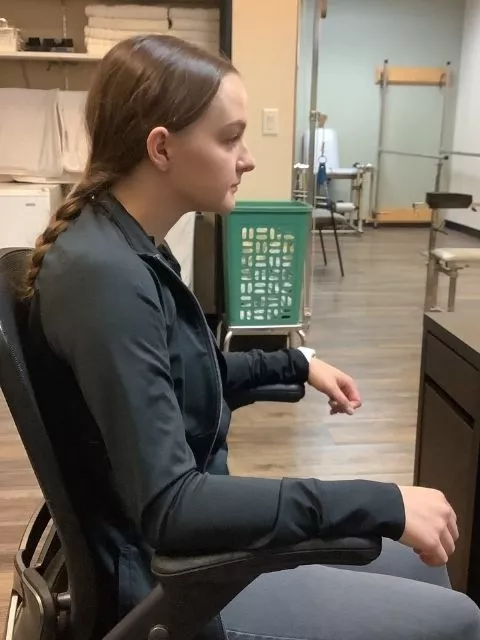
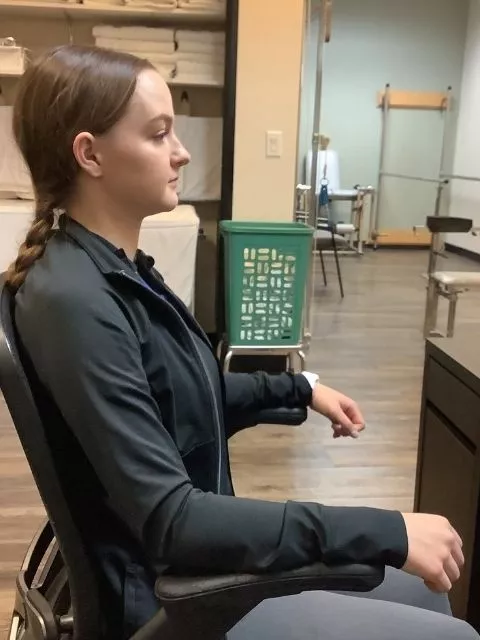
Malocclusion (cross bite)
This may be a symptom of tightness on one side of the TMJ or it may in fact be a primary cause of TMJ.
Excessive Gum Chewing
If you chew gum on a constant basis this may cause some overuse of the TMJ on both or one side. If you have TMD, gum chewing will exacerbate the problem.
Emotional stress
Stress can increase muscle tension in the head and neck leading to or exacerbating TMD and pain
Maintaining an open mouth
This may happen at the dentist, using a scuba mouthpiece, certain orthodontic appliances or even after post-surgical intubation. Often maintaining this type of positioning of the joints can lead to pain.
Griding your teeth, “Bruxism”
People often have a habit of grinding their teeth or clenching their jaw, especially at night. This may lead to mechanical stress
When evaluating your own TMJ bear in mind that you should be able to eat, speak, and sleep with out pain. The average amount of opening is about being able to at 3 fingers into your mouth without pain. As mentioned earlier, there is a small disc in the joint that can get impinged and cause a locking of one or both TMJs.
How to treat TMJ at home in 2 minutes!
Now, the moment you’ve been waiting for: TMJ home treatment suggestions. Try these suggestions to find relief:
Watch your posture
- When sitting at the computer, avoid forward head posture.
- When watching TV, avoid laying on your stomach or side with your chin propped on your hands.
- Tell your dentist and hair stylist you have TMJ so that he/she can help minimize stress on your TMJ when you get your teeth cleaned or hair shampoo.
- Do not sleep on your stomach or on the painful side.
- If you grind your teeth, wear a professionally fit splint or bite guard.
- Massage your tense muscles. Specifically the masseter and temporalis:
Self massage
Perform gentle traction through your TMJ. Sit up tall with your mouth hanging open. Gently grasp the back corner of your jaw with the palm of your hand on the side of your face. Gently pull down while staying relaxed in your face and neck.
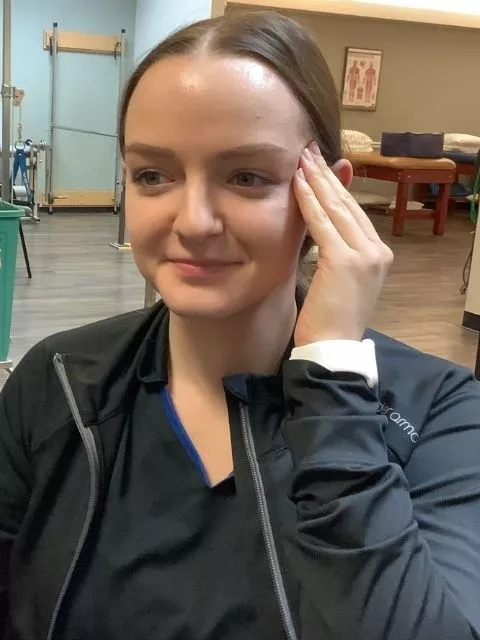
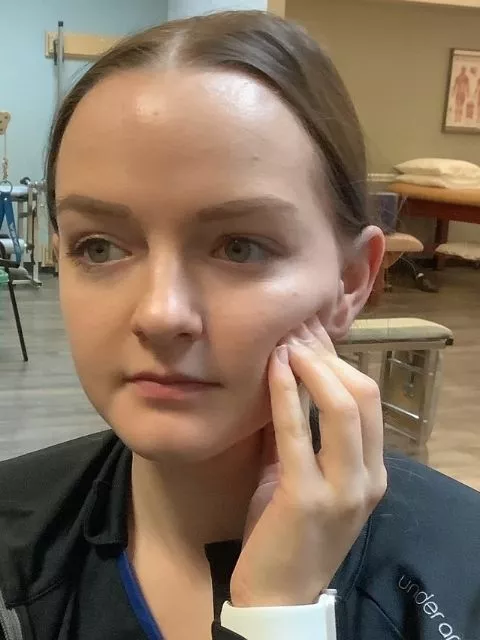
TMJ Specific Exercises
General spinal stabilization exercises are beneficial in managing TMD. Aerobic conditioning is helpful in relieving stress and muscle tension. Specific isometric exercises may also help relieving pain from the TMJ specifically. Yoga is an excellent and anti-inflammatory form of exercise to try.
Lateral deviation
Many of these exercises involve jaw movements. Sit with your mouth hanging open in a relaxed position. Take two fingers, place them on the left side of your chin. Gently push to the right and with your jaw muscles resist the rightward movement of your jaw. Repeat on the other side.
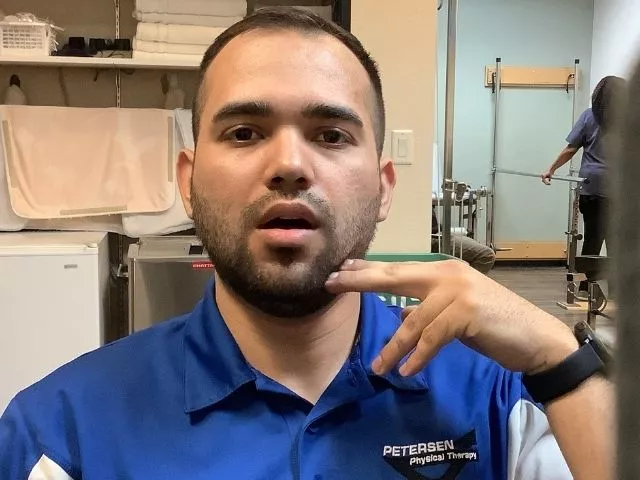
Hold for a count of 3 and repeat 10 times. Repeat on the other side.
Protraction
Sit with your mouth hanging open in a relaxed position. Take two fingers, place them on the front of your chin. Gently push back and with your jaw muscles resist the backward movement of your jaw.
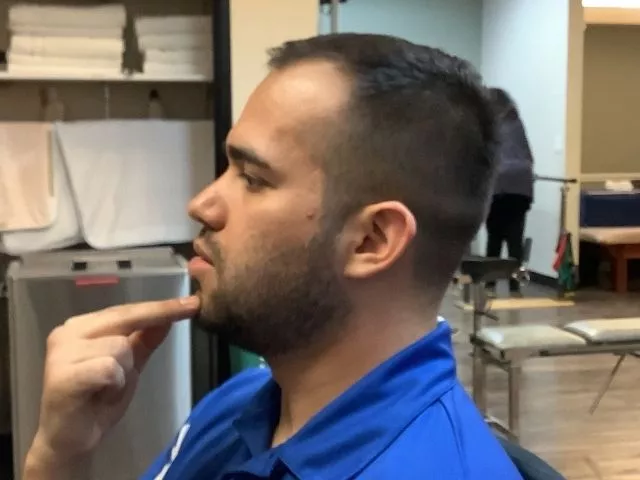
Hold for a count of 3 and repeat 10 times.
Resisted closing
with your mouth hanging open in a relaxed position, place your tongue on the roof of your mouth. Gently and slowly close your mouth while offering resistance with your tongue.
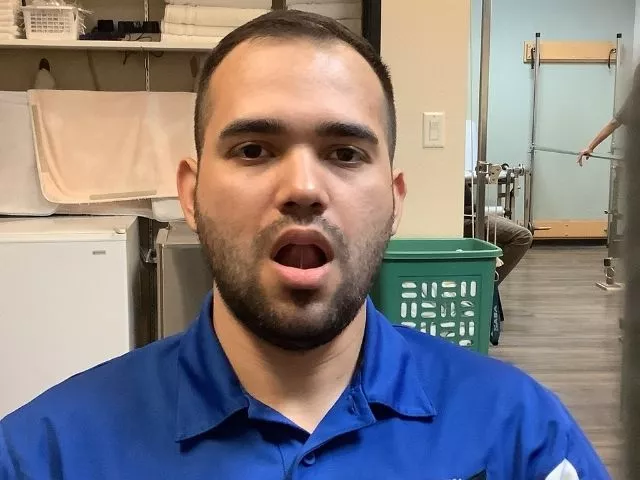
Repeat 3 sets of 10 reps.
What else may help?
Often the pain and dysfunction is severe enough or has persisted for a period of time and you might need some expert help. If the above TMJ home remedies don’t work, be sure to discuss your TMJ symptoms with your doctor or dentist. Many treatment options exist:
Counseling (stress management), massage therapy, injections, physical therapy and medication may all be helpful, alone or in combination. Surgery for TMD is a last resort and should be considered for only the most severe cases with clear surgical objectives. The majority of cases can be resolved with conservative management, such as those described in this post.
Our area of expertise is in physical therapy.
What will your physical therapist do for TMJ?
Physical therapy can help with TMJ in a number of ways. You will first receive an evaluation to examine your posture, strength, joint mobility and interaction between your nerves and muscles. This evaluation will not be limited to your TMJ but will encompass the head, neck and upper back at a minimum. Assessment of lifestyle and activities of daily living will also be assessed to identify potential contributing factors.
Once your Physical therapist has completed the examination a set of goals will be established and a treatment plan will be outlined.
This treatment plan will include many parts. Modalities to decrease pain and inflammation may include dry needling, electrical stimulation, ultrasound, or heat / ice packs. Manual therapy to restore mobility, decrease muscle tension, and to inhibit pain will very likely be incorporated into the plan.
Therapeutic exercise is always part of a comprehensive physical therapy treatment plan. These exercises are designed to assist with relaxation, joint mobility, and postural correction. Finally, an essential component of an effective treatment plan to help deal with TMJ dysfunction is education. The educational component will emphasize avoiding the mechanical and emotional stressors that trigger pain in the TMJ, self-management techniques, and TMJ home treatment exercises going forward.
Please do not suffer alone.



